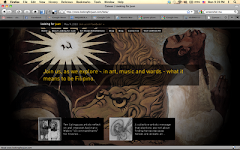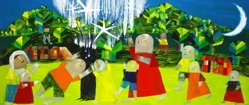The Bold and the Beautiful
By Lara Day/Manila
"Why does everyone love Bangkok and Havana? Even Mumbai sounds better than Manila," says Filipino conceptual artist Yason Banal over coffee in Quezon City. There isn't an immediate answer. The Third World cities he lists aren't immune to the challenges that beset the Philippine capital: all grapple with congestion, crime and corruption, and none escape the banes of poverty, heat, seediness or pollution. So perhaps it's a question of marketing. Tourists are drawn to destinations with double-pronged, p.r.-friendly pegs—saris and spices for Mumbai, cigars and salsa for Havana, markets and temples for Bangkok. Manila, with its bewildering collision of Spanish, Mexican, Malay, Chinese, American and Arabic influences, doesn't benefit from such glib categorization.
Every week in Intramuros, the old walled city in whose heart, the San Agustin Church, I was christened, tour guide Carlos Celdran peels back the city's colonial layers and shows why the texture of this city doesn't lend itself to glossy hooks. I haven't taken his tour before. In fact, today, I'm bleary after staying up to watch Cebuano reggae act Junior Kilat play saGuijo's in Makati, and as I sluggishly make my way to the Fort Bonifacio meeting point, I yearn to crawl back under the covers. But witty, hilarious Carlos jolts me into wakefulness. Interspersing trenchant facts with lively anecdotes, he hurtles through 600 years of Filipino history, and, all of a sudden, Manila begins to make sense.
"If you can't find beauty in Manila, you won't find it anywhere," he quips as we later scarf Chinese takeout in his high-ceilinged Malate apartment. I find it impossible to disagree. Manila's aesthetic isn't perfect, and that's its attraction. There's an ironic local expression that sums it up: Frankenstein. It describes an old object or concept injected with new life through fresh components—"antique" chairs bolstered by new arms and legs, jeepneys revamped with transplanted motors and fresh paint jobs (a new MTV program, Pimp My Jeepney, is in the works), to ukay-ukay, or rummage-sale, vintage clothes stitched together with modern materials and prints. To me, Frankenstein explains the city's visual style as well as its strength and resilience. Improvisation and cheerfully making do characterize the Filipino attitude toward poverty.
That poverty may be ubiquitous, but so is the energy. Teeming, corrugated-iron slums surround decaying Art Deco mansions. Lush bougainvilleas peek from behind high stone walls trimmed with barbed wire. Chapels hear confession in the middle of decadent shopping malls, and hand-painted billboards advertising movies like Brazen Women overlook vendors touting T-shirts that read JESUS OF NAZARETH. At stoplights, peddlers tap on your window proffering newspapers and Marlboro Reds, while children wave garish feather dusters and delicate lace handkerchiefs. And wherever you go, there is music, in the endless strips of "videoke" lounges, pouring forth from bars and clubs, and in the broken strains of a busker's ukulele.
I head to Quiapo, where I wade through a sea of stalls selling bootleg DVDs and used electronics, pirated porn and secondhand bridal gowns. Exotic fare abounds, but I opt for a simple treat from childhood: a bananacue, or banana speared with a skewer, caramelized in deep-fried sugar. As I savor the sweet, sticky snack, I listen to a sermon blasted from a loudspeaker by a church decorated like a pastel Easter egg; in front of me is a row of old women selling religious figurines along with herbal potions that claim to do everything from curing coughs to terminating unwanted pregnancy. Afterwards I walk to Chinatown, where merchants hawk watermelons, pearls, watches and glutinous rice cakes. Padyaks, or pedicabs, painted with names like Raymond and Alfonso are lined up for action, while a jeepney called Jeremiah 616 whizzes by in an eye-catching streak of fuchsia and peacock blue.
That's the kind of beauty Manila offers: not obvious, but undeniable once you've encountered it. My grandmother has lived here for almost nine decades, through World War II and the Marcos years. One afternoon, while stuck in traffic on Roxas Boulevard, she suddenly exclaims 'Maganda!' (Beautiful!). I look to where she is pointing: a few scraggly, nondescript bushes sit on the divide between a choking 12-lane thoroughfare. But then I look closer: at the tips of the sparsely covered branches are clusters of tiny, vivid scarlet buds. Amid this congested, often dilapidated city, they're right there, just waiting to be noticed.





No comments:
Post a Comment